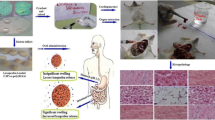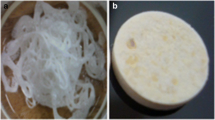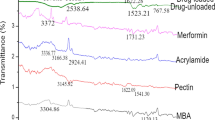Abstract
Polymethacrylic acid (PMA) was synthesized on the backbone of psyllium (Psy) by a microwave assisted method to prepare polymeric grafted materials designated as (Psy-g-PMA). Various grades of Psy-g-PMA were prepared by changing the degree of grafting from 35%–58% and the materials were then made into tablets. Swelling and biodegradability studies of the tablets were carried out. Acetyl salicylic acid was incorporated in the various Psy-g-PMA samples and tablets were prepared to study the in vitro drug release in acidic (pH = 4), neutral (pH = 7), and basic (pH = 9) media. In the acidic medium, the swelling was more than 1300%. In addition, the biodegradable Psy-g-PMA had the highest drug release in the acidic medium. This may be attributed to Fickian diffusion since the drug and the medium in which it was released have the same acidic nature.
Similar content being viewed by others
References
Camilia G. Miche, Demiana I N, Nesrine S E, Taha S E. Bioactive aqueous extract of Nigella sativa L. seed waste: formulation and evaluation. Journal of Chemical and Pharmaceutical Research, 2011, 3: 213–225
Wong T W. Chitosan and its use in design of insulin delivery system. Recent Patents on Drug Delivery & Formulation, 2009, 3 (1): 8–25
Pal S, Sen G, Mishra S, Dey R K, Jha U. Carboxymethyl tamarind: synthesis, characterization and its application as novel drugdelivery agent. Journal of Applied Polymer Science, 2008, 110(1): 392–400
Gils P S, Ray D, Sahoo P K. Controlled release of doxofylline from biopolymer based hydrogels. American Journal of Biomedical Sciences, 2010, 2: 373–383
Singh B, Pal L. Development of sterculia gum based wound dressings for use in drug delivery. European Polymer Journal, 2008, 44(10): 3222–3230
Omidian H, Park K. Swelling agents and devices in oral drug delivery. Journal of Drug Delivery Science and Technology, 2008, 1–418: 83–93
Singh B, Chauhan G S, Sharma D K, Kant A, Gupta I, Chauhan N. The release dynamics of model drugs from the psyllium and N-hydroxymethylacrylamide based hydrogels. International J Pharmaceutics, 2006, 1–4325: 15–25
Singh B, Bala R. Design of dietary polysaccharide and binary monomer mixture of acrylamide and 2-acrylamido-2-methylpropane sulphonic acid based antiviral drug delivery devices. Chemical Engineering Research & Design, 2012, 90(3): 346–358
Singh B. Psyllium as therapeutic and drug delivery agent. International Journal of Pharmaceutics, 2007, 334(1–2): 1–14
Yasir M, Asif M, Bhattacharya A, Bajpai M. Development and evaluation of gastroretentive drug delivery system for theopylline using psyllium husk. International Journal of ChemTech Research, 2010, 2: 792–799
Mehmood M H, Aziz N, Ghayur M N, Gilani A H. Pharmacological basis for the medicinal use of psyllium husk (Ispaghula) in constipation and diarrhea. Digestive Diseases and Sciences, 2011, 56(5): 1460–1471
Kumar K, Kaith B S. Kaith B S. Psyllium and acrylic acid based polymeric networks synthesized under the influence of g-radiations for sustained release of fungicide. Fibers and Polymers, 2010, 11(2): 147–152
Peepas N A. Hydrogels and drug delivery. Current Opinion in Colloid & Interface Science, 1997, 2(5): 531–537
Mittal H, Kaith B S, Jindal R. Synthesis, characterization and swelling behaviour of poly(acrylamide-comethacrylic acid) grafted Gum ghatti based superabsorbent hydrogels. Advances in Applied Science Research, 2010, 1: 56–66
Kumar R, Sharma K, Tiwary K P, Sen G. Polymethacrylic acid grafted plantago psyllium mucilage (Psy-g-PMA): a novel material for waste water treatment. App Water Sci, DOI: 10.1007/s13201-013-0081-6
Kalsi P S. Spectroscopy of Organic Compounds. 5th ed. New Delhi: New Age International (P) Limited, 2002, 60–181
Sen G, Pal S. Microwave initiated synthesis of polyacrylamide grafted carboxymethylstarch (CMS-g-PAM): application as a novel matrix for sustained drug release. International Journal of Biological Macromolecules, 2009, 45(1): 48–55
Moore D J, Palmer J C, Liu Y C, Roussel T J, Brennan J K, Gubbins K E. Slow and fast (Fickian) diffusion modes for argon confined in BPL activated carbon. Diffusion Fundamentals Org, 2009, 95: 1–4
Author information
Authors and Affiliations
Corresponding author
Rights and permissions
About this article
Cite this article
Kumar, R., Sharma, K. Biodegradable polymethacrylic acid grafted psyllium for controlled drug delivery systems. Front. Chem. Sci. Eng. 7, 116–122 (2013). https://doi.org/10.1007/s11705-013-1310-0
Received:
Accepted:
Published:
Issue Date:
DOI: https://doi.org/10.1007/s11705-013-1310-0




